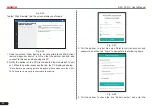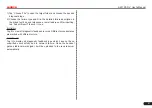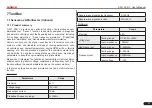
LAUNCH
X-431 PAD V
User's Manual
49
4
Power adapter
To supply power to the
Sensorbox through connection to
AC outlet.
5
Battery clamps cable
To supply power to the
Sensorbox through connection to
vehicle's battery.
6 Electronic control converting
cord 1
7 Electronic control converting
cord 2
7.1.3 Sensor Simulation
7.1.3.1 Connections
1. Firstly, power on the diagnostic tool.
2. Connect the B-shaped terminal of data cable to the B-shaped port
of the Sensorbox, and the other end to the Data I/O port of the
diagnostic tool.
3. Plug one end of the sensor test cable (black) into the “COM”
interface of the Sensorbox, then connect the other end to the test
probe or electronic control converting cable.
4.
Connect one end of the sensor test cable (red) into the “VΩHz”
interface of the Sensorbox, and then connect the other end to the
test probe or electronic control converting cable.
*Note: Choose corresponding cables and test probes according to different
terminals.
7.1.3.2 Simulation test
Simulation test enables users to exactly judge if the sensor is good or
not to avoid replacing components blindly. For example, the trouble
code indicates the fault is in water temperature sensor itself. But we
need to confirm whether the fault results from water temperature
sensor or the connections between ECU and sensors, or ECU itself.
In this case, we can make full use of simulation test to input the signal
of simulating water temperature sensor, instead of water temperature
sensor, to the microcomputer. If the engine works better and the fault
vanishes, the fault is in the water temperature sensor. If the fault
still occurs, input the signal to the corresponding terminals of ECU.
Consequently, if the fault disappears, the fault lies in the connection
between water temperature sensor and ECU, otherwise, the fault
exists in ECU.
After all connections are properly made, power on the diagnostic tool,






























